The deadliest human tussle ever recorded was World War 2, as it involved atomic bombardments, paratroopers, and poisonous gasses resulting in vast death tolls.
The world’s significant powers got divided into the Allied Powers and the Central authorities.
Intense militarism helped the nations to protect themselves and compete for power which gave rise to imperialism.
Adolf Hitler, Benito Mussolini, Winston Churchill, and Joseph Stalin were prominent leaders who mobilized their armies to extend their powers.
Around 70 million armed forces accompanied by the navy, air force, and land force got involved in the WW2 battle, resulting in 70-85 million casualties.
This article lists the Top 10 foremost military leaders in combat with their contributions and significant events.
10. Douglas MacArthur of the United States (1880-1964)
Content

Macarthur, a chief general of the American Army during1930’s, was born to American Civil War hero Arthur MacArthur Jr. and Mary Hardy.
He was best known for his prominent role in the southwest pacific theater in world war 2.
MacArthur attended the United States Army in 1899 at WestPoint and graduated as the best student in 1903.
After graduation, he served as the second lieutenant in the U.S Army Corps of Engineers.
The service was commissioned in the Philippines, so he could travel to several other Asian countries like Japan, China, Indonesia, etc., and shortly returned to the U.S.
When World War 1 began, he got promoted to Colonel and received many honors for his bravery. He was awarded purple hearts, Distinguished Service Crosses, and Brigadier General position.
MacArthur fought with extreme fierceness and convictions when Japan attacked Pearl Harbor, the U.S. But situations did not favor his troops, so he was ordered to leave for Australia.
He returned to the Philippines with a proactive strategy known as “Island Hopping.” The supplies of Japanese troops on the island were cut off, leaving them with no alternative but to surrender.
Finally, in September of 1945, Japanese troops surrendered to the U.S armed force led by MacArthur.
He was given the Field Marshal title while preparing for the Philippines’ Army and defense systems against possible Japanese aggression.
A man of extraordinary potency, strength, and intelligence who surpassed the Japanese Army retired on April 10, 1951.
He captured all of his experiences in his autobiography “Reminiscences.” He undoubtedly presented both physical and moral qualities essential for military duties.
9. Erwin Rommel of Germany (1891-1944)

Erwin Rommel was a German general renowned for warmongering skills in World War 2. He was even nicknamed “the Desert Fox” for his surprise attacks.
On November 15, 1891, Rommel was born in Germany and was encouraged to join the military services by his family.
He participated in World War 1 as a lieutenant after joining the German infantry in 1910.
The second world war provided him a chance to prove his bravery and tenacity. He was deployed as North America’s commander-general of the Afrika Korps in 1940.
However, Italy lost to Britain in North America, which forced Hitler to send him to Libya. He returned with powerful tactics and culminated in defeats of British armies in the Battle of Gazala.
He was praised for sudden yet power-packed attacks even by the enemies. Hitler, content with his performance, promoted him to Field of Marshal. He was regarded as one of Hitler’s best commanders.
In 1944, Rommel was handed over safeguarding France’s Coast. A clash of strategies arose between German forces, leading to its loss against Allied power. Rommel got severely injured.
Despite his loyalty to Hitler, Rommel was implicated in a bomb plot against Hitler in July 1944. Out of terror, he committed suicide, but Nazis interpreted it as Rommel had died of his wounds to the public.
He was much admired for his moral ethics, even towards war prisoners. Rommel was a daring, deceptive, yet speedy German general referred to as the “People’s Marshal.”
8. Georgy Zhukov of Russia (1896-1974)
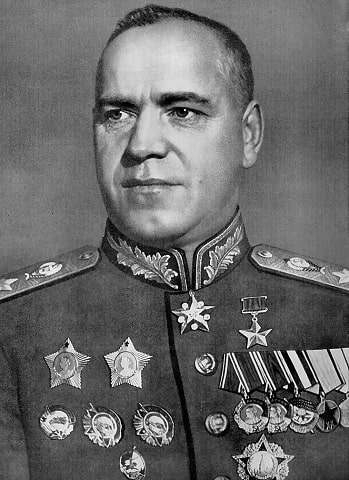
Georgy Zhukov was a Russian military leader who portrayed a significant role during world war 2. He was known for his loyalty towards senior commanders but always felt the necessity to give contrary feedback.
Zhukov was born in Kaluga, Russia, to a poverty-crushed family. He had to work as an apprentice before World War 1 due to his family background.
He attended the Frunze Military school and joined the Red Army around 1917.
He participated in the Russian Civil war (1918-1921) against the Tsar regime, which got him the red banner order and the Corps position.
The Battle of Khalkhin Gol against the Japanese who invaded Mongolian territory marked his first victory in 1939.
Stalin appointed him to combat against the German during “Operation Barbarossa” as an army general. He positioned his forces as per their potency and drawbacks.
The victory during the German salvation of Moscow through his brilliant counter-offensive plans drew Germans out of Russia in 1942. It got him elevated to Deputy Commissioner of Defense.
Germans stemmed from Russia under forces led by Zhukov during World War 2. He showcased good infantry and artillery abilities that promoted him to “Marshal of Soviet.”
Stalin saw him as a threat, but after his death, Zhukov unlocked new heights of success.
In 1957, he retired after being made a member of the Presidium. He could foresee the pros and cons of battlefields, drafted maps by terrain studies, and used them to figure out the best fighting positions.
7. Bernard Montgomery of Britain (1887-1976)
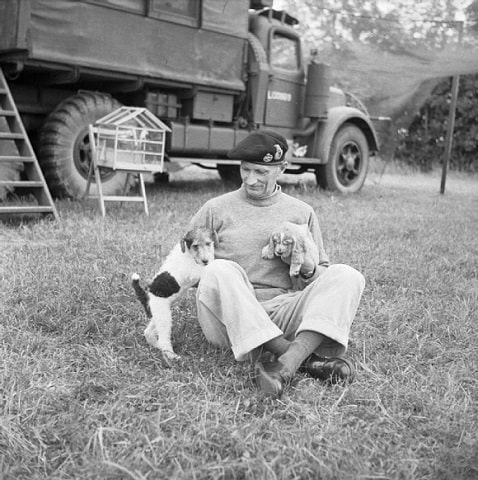
Bernard Law Montgomery was a British commander during World War 2 who was notoriously vain.
He believed that truth was the primary character whom people could trust. But his fellow commanders considered him self-infatuated and arrogant.
Montgomery, nicknamed “Monty,” was born in London in 1887, graduated from the Royal Military College, and joined the Royal Warwickshire Regiment.
In 1914, he fought his first battle of Ypres. He was appointed as a lieutenant, followed by Colonel for his bravery. His career reached its peak during the outbreak of World War 2 as he was elevated to Commander of the Eighth Army in Egypt.
With his tactical retreat, Montgomery safely evacuated over 333800 French and British soldiers from Dunkirk during “Operation Dynamo.”
Erwin Rommel and Bernard Montgomery fought against each other in the battle of El Alamein in 1942. The action was crucial to both parties as it led to oil access from the Middle East and supplies from Asia.
The Germans and Italians lost it to Britain, marking the land triumph of the Allies.
After El Alamein, Monty was admired for his resilience and showmanship. He took part in battles against Italy in 1943, forcing the axis powers to confront him.
Similarly, the invasion of Western Europe lied on Montgomery’s success despite disagreements with General Patton and General Eisenhower.
The British Field Marshal resumed military service even after the war. He was a successful military man who defeated Erwin Rommel twice and was praised for unorthodox and eccentric habits.
6. Erich Von Manstein of Germany (1887-1973)
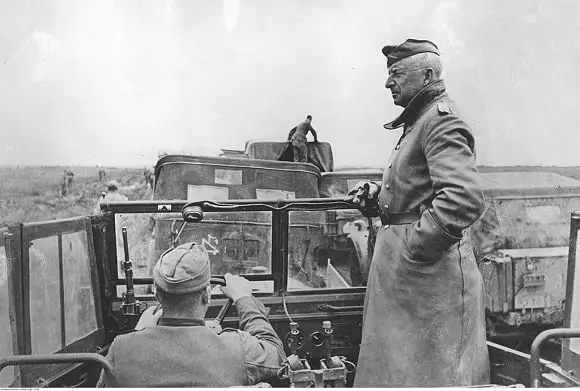
Manstein was one of the elite commanders who saved Germany on multiple occasions with his excellent war techniques in World War 2. His revolutionary plan, “The Manstein plan,” helped Germany defeat France in 1940.
General Geoff Manstein adopted him after the untimely demise of his parents. He got a chance for military exposure during World War 1 on the Russian and Western fronts.
Manstein was upgraded to major general and then to lieutenant in 1938. He got to serve under General Gerd von Manstein for the invasion of Poland. Adolf Hitler personally adopted plans for France’s invasion via the Ardennes Forest.
Russia was invaded in 1941, providing him with the 56th Panzer Corps and then to 1th Army Corp in September of the same year.
Around 430,000 Russian people were imprisoned after the invasion. He got promoted to Field of Marshal after capturing Sevastopol in 1942.
The battle of Kharkiv turned in favor of the Germans after several attempts in 1943. Manstein was able to destroy Soviet armies halting their advances.
He was not ready to spare a piece of land despite Hitler’s orders during the battle of Kursk in 1943. Thus, he had to face a tragic defeat against Russia.
Nevertheless, Manstein was a brilliant commander, but his troublesome decisions caused an early retirement in April 1944. was remembered as one of the few who could confront Hitler.
5. Italo Gariboldi of Italy (1879-1970)
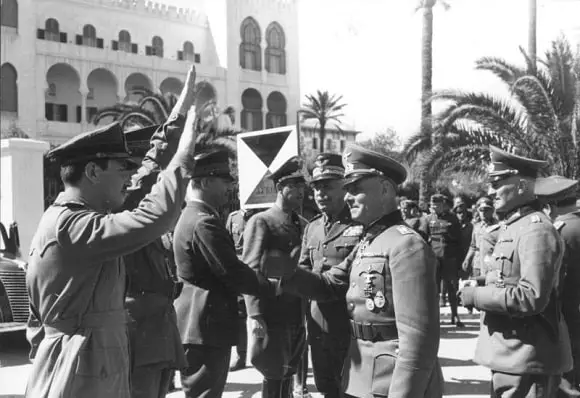
Italo Gariboldi was one of the most decorated Italian military figures who gained fame invading Ethiopia. Not many Italian military men were regarded as powerful, yet he proved to be one.
Italo was born in 1879 in Lombardy, Italy. He served in the Royal Italian Army during interwar and World War 1. After the war, his rank upgraded, so he commanded various regimental, brigade-level forces.
In 1935, Italo commanded the 30th Infantry Division of Italy and the 5th Army near the Tunisian border.
He acted as the general of the 10th Army and invaded Ethiopia to boost Italian prestige.
However, he lost the battle of Stalingrad while serving in the Italian Army in Russia between 1942-1943. Nazi Germany arrested him in 1943.
4. Isoroku Yamamoto of Japan (1884-1943)

Yamamoto was Japan’s most eminent Naval officer during WW2 who attacked Pearl Harbor, the U.S naval base, on December 7, 1941.
Isoroku Yamamoto graduated from the Japanese Naval Academy and participated in the Battles of Tsushima between Russia and Japan.
He was sent to the U.S as an aide to an admiral after completing flight training in 1926.
The Technological Division of the Naval Corps of Japan was led by Yamamoto, who developed fighter planes and several naval innovations.
He commanded the First fleet in 1938, followed by the Combined fleet in 1939, while preparing Japan for future wars.
As a senior admiral in the Japanese fleet, he argued for war against the U.S after invading Southeast Asian nations. Emperor Hirohito adopted his ideas, so Yamamoto made preparations for attacks.
In 1941, Imperial Japanese Naval, led by Yamamoto, made a sudden attack on Pearl Harbor to cripple U.S forces for negotiations with Japan. He bagged a tactical victory yet was unaware of the consequences.
The attack enraged Americans, so they bombarded Hiroshima and Nagasaki with the deadliest nuclear weapon ever; the atom bomb.
In April 1943, he died after his plane was shot down. He was one of Japan’s reputed naval officers who ensured long-range nautical attacks.
3. Curtis Lemay of the United States (1906-1990)

Curtis Lemay was a general of the United States Air Force entitled with a famous quote, “Bomb them to the Stone age.”
He was profound for implementing and designing bombing campaigns in Pacific Theater during World War 2.
LeMay entered the U.S air force in 1928, after which he was promoted to bombardment commander in 1942.
He developed bombing orientations, designed combat boxes, etc., and commissioned air attacks on Germany and North Africa.
After the Pearl Harbor attack, he was set up for air operations against Japan. However, bombing Japan was not a piece of cake as the skyrocketing Himlayan trails had to be surpassed. Thus, U.S bases captured Mariana Island.
In 1945, more than sixty-three Japanese cities were devastated by advanced bombs “Little Boy” and “fat man.” Japan got shattered into shreds when its major cities piled up into ashes.
LeMay continued his service and got ranked as the chief of staff of the U.S before retiring in 1965.
2. William Slim of Britain (1891-1970)
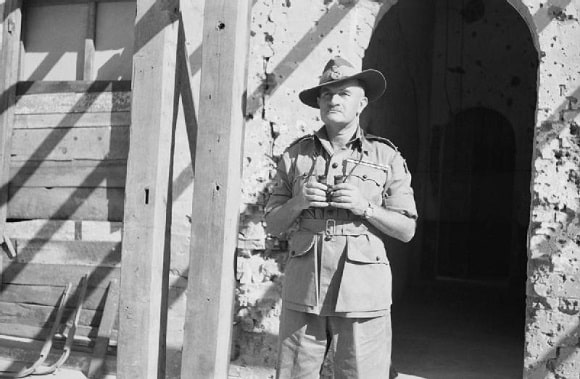
William Slim was the British Field Marshal who supervised Supreme Allied campaigns in Southeast Asia. He was contemplated as the finest general World War 2 produced.
He served in the Royal Warwickshire Regiment during World War 1 and was awarded the Military Cross for outstanding accomplishments.
In 1938, he commanded the 2nd Battalion and 7th Gurkha rifles. Slim led the 10th Indian Division during the Iran invasion.
His significant performance was as the 14th Army in Burma Corps in 1942, whom the Japanese had overthrown. Slim exercised jungle warfare training formed defense boxes and retained his fellow mate’s confidence more importantly.
Finally, he was able to chase the Japanese out of Rangoon in the battle of Imphal and Kohima in 1944. The troop’s endurance and Slim’s special superintendence marked the Allied power’s victory.
Later on, he served as governor-general of Australia between 1953-1960.
1. Carl Gustaf Emil Mannerheim of Finland (1867-1951)
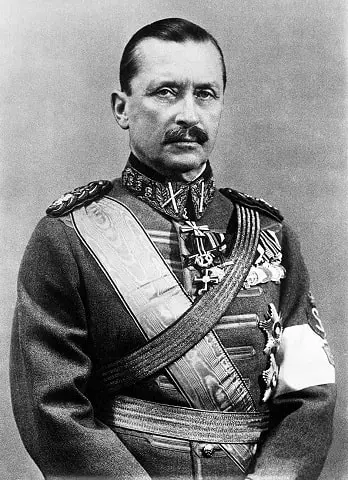
Carl Gustaf Mannerheim was Finland’s most exemplary war hero, considered a soldier than a president. He amazed the world with impeccable bravery and heroism.
Born to a wealthy family in Helsinki, Mannerheim was instilled with discipline at a very young age.
He was in the Russian Army just before Finland attained independence in 1917.
Russian forces were chased out of Finland during the Finish Civil war, which led him towards becoming a Finish regent in 1918.
The entire world witnessed his outstanding accomplishment during 1939-1940. A 105-day-long resistance against a giant Soviet force without surrendering was an astonishing act.
Finland allied with the Nazis to launch an attack on the Soviets to restore its territory. But they failed as Germany weakened.
Finally, a peace agreement was made between Finish and the Soviets after Mannerheim became the President in 1944. Mannerheim resigned after his health deteriorated in 1946.
Conclusion
The war marked its end in 1945, showcasing the extraordinary courage of those who fought.
The generals were decorated with prestigious war medals like Victoria Cross, Burma star, Atlantic star, Pacific star, etc., for their impeccable bravery.
Most war veterans lost their lives while others returned to their everyday lives. But what they left behind was a legacy of extreme fearlessness.
